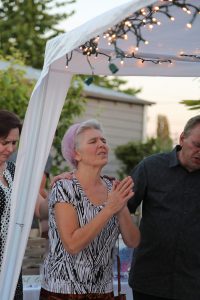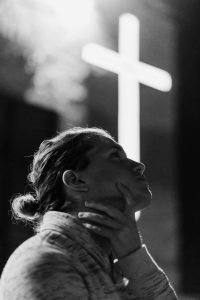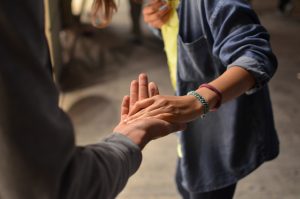Bearings
Returning the Call
What My Mom’s Cancer Allowed Me to Learn about Religion and Coping
By Jaime Wright
June 2019 Issue

I remember leaving a message for my mom the last time she was in the hospital. I let her know that I would be leaving in the morning to visit and that I expected, as usual, that she would be fine by the time I got there. The conventional wisdom in my family was that my mom was nearly superhuman. Every time that cancer, and later circulatory problems, took her down sometimes leaving her bedridden, she would somehow, always, bounce back from the edge of the health crisis or even death.
When I was in the fifth grade, my mom was first diagnosed with breast cancer. Actually, she had had lumps in her breasts for a few years before she was diagnosed by a doctor. She had this belief, stemming from her father’s death from cancer, that once the doctors sliced open the flesh to excise the cancerous tumors the cancer would rapidly metastasize upon being exposed to air. Her father had died shortly after surgery related to cancer.
Nonetheless, by the time she was diagnosed, it was only a matter of days before she underwent a radical double mastectomy that would leave scars the width and length of two uncooked strips of bacon across her chest. As my mom recounted later, one of the tumors removed was the size of an orange. My mom used to joke that the doctors hadn’t even expected her to live long after the surgery considering the size of the scars and the fact that both the wounds where her breasts once were split open more than a few times during the healing process. But heal, she did.
After the surgery came the chemotherapy—the roughest part of her cancer experience. The nausea, hair loss, and severe chronic fatigue brought with it many days in which my mom could barely function. Yet she bounced back from that as well. A few years after chemotherapy, my mom went through multiple surgeries for breast implants and for areolas and nipples.
Over the years, cancer would play hide and seek. Remission at five years; relapse at ten. When the cancer came back, they caught it early enough to treat it with radiation, which, poorly aimed, ended up shriveling one of her breast implants. It felt, ironically enough, like an orange against my chest whenever I gave her a hug.
When cancer took a break again, my mom’s circulatory problems demanded that she undergo multiple surgeries for stents in her arteries. But by the time I was in my mid-20s, breast cancer had returned. This time it had found its way into her clavicle bone.
These are just some of peaks of her storyline. But, like I said, she seemed to have a superhuman ability to leap these peaks in a single bound. I was confident she would again.
 After I left that message, however, I never received a call back from my mom. I was notified by my sister the following day that mom had died in the hospital. Later, I would find out that even though she had orders not to resuscitate or put her on any type of life support, well-meaning and protocol-following nurses had strapped her down to the hospital bed because she was trying to pull out whatever they had put down her throat or needled into her arm.
After I left that message, however, I never received a call back from my mom. I was notified by my sister the following day that mom had died in the hospital. Later, I would find out that even though she had orders not to resuscitate or put her on any type of life support, well-meaning and protocol-following nurses had strapped her down to the hospital bed because she was trying to pull out whatever they had put down her throat or needled into her arm.
Through the last phase of her life, I was beginning the general outline and research for my doctoral dissertation. I wanted to know more about how women with breast cancer used religion and spirituality to frame and cope with the disease. I was still in the early stages of the process. I had shared my idea with mom and had let her know that she had inspired this research project. I’m glad that she knew about this before she died.
My mom’s own religiosity and spirituality were central in her experience of cancer. When talking about her faith, she said that from a young age, she had some natural inclination to seek God even though her family did not regularly attend church or talk about God. It was during difficult times in her life that I would hear her pray or mention God the most. This was especially the case when it came to working through the physical, emotional, and psychological misery that breast cancer brought into her life.
It was then, in my early teens, that my parents and I began attending church. My parents attended a Foursquare Christian church that was held in the pastor’s home. It was a new and small community of about five families. This was ideal in many ways because the church functioned as an extended family whose members helped by bringing meals or, if my dad was at work, by providing rides to doctor appointments or chemotherapy. My mom’s relationship to the church community, as well as to God and Jesus, deepened and flourished as she recovered and healed.
During this time, I often heard my mom praying and asking for strength as she struggled through daily tasks. At church on Wednesday nights and Sundays, people would gather around my mom, lay hands on her, and pray for her. Back at home, even though there were only three of us living in our house, considering how much my mom talked to them, it was as if God or Jesus were always present there, too. They were additional, but invisible, family members who were there 24/7 to offer emotional or spiritual support for my mom.
These memories of my mom’s religiosity remained heightened points of interest for me as I grew older. For reasons beyond my grasp—beyond a general skepticism—I never really “took to” religion. Still, I could see how it helped provide my mom with solace and strength. I even saw it bring my parents closer together. Their relationship after becoming born-again Christians was much calmer and more loving than years prior. It had real, concrete effects in their lives, even though it never connected emotionally or spiritually for me.
Still, witnessing this, I became fascinated with religion from an intellectual perspective. This same fascination led to majoring in religious studies and later pursuing, as a self-identified atheist, a doctoral degree in ethics and social theory. It was this same fascination, albeit more personal, that led to a dissertation that examined the intersection of breast cancer, religion, and identity.
As part of my research, I surveyed and interviewed women with breast cancer in the greater San Francisco Bay Area who were part of a larger, longitudinal study of breast cancer survivorship, the Pathways Study. In the interviews, women discussed how they used religion as a resource during their health crises. For example, when women in my study utilized prayer, they overwhelmingly used it for purposes of finding comfort, peace, strength, and even thankfulness. They weren’t seeking miracle cures.
 This use of prayer reflects the use of religion as a psychological resource according to sociologists of health and religion, Christopher G. Ellison and Andrea K. Henderson. In this sense, one constructs an ongoing relationship with “divine others”—academic jargon for God or gods—through prayer. Such prayers, as reviewed by Ellison and Henderson, and reflected in my own research, can take the form of conversations, meditations, and petitionary prayers.
This use of prayer reflects the use of religion as a psychological resource according to sociologists of health and religion, Christopher G. Ellison and Andrea K. Henderson. In this sense, one constructs an ongoing relationship with “divine others”—academic jargon for God or gods—through prayer. Such prayers, as reviewed by Ellison and Henderson, and reflected in my own research, can take the form of conversations, meditations, and petitionary prayers.
In addition, my mom and the women with breast cancer in my study developed relationships with a divine being to help bolster strength. Kenneth Pargament, a psychologist who studies religion as a coping resource, describes this as a collaborative religious coping strategy in which someone like my mom would see God or Jesus as working with her to solve problems, relieve anxieties, or make sense of what’s happening. He contrasts people with such collaborative coping strategies with those who are indifferent to the presence of God or those who see themselves as deferring or being obedient to God’s will (p. 181). Pargament’s research shows that such collaborative coping skills are often correlated with higher measures of emotional well-being.
Finally, my mom’s experience with her church demonstrated the positive aspects of social support and social integration (i.e., interactions within her community). Ellison and Henderson discuss how religious membership can be a social resource wherein a religious community provides tangible assistance and emotional support. Sharing beliefs contributes to stronger bonds, and attending church events regularly increases the frequency of interactions. These are characteristics of integration into a strong social network. Religious communities are not the only places in which such social integration can happen, but they are well structured across the globe, relatively stable over time, and reasonably durable—you generally know that the house of worship down the street will still be there next week—even in times of religious change.
Social integration and support have important effects in general, but they are arguably elevated for people with cancer. Higher measures of religious social integration as positively correlated with higher levels of physical and mental health have a long history in sociological work dating back to Emile Durkheim’s study of suicide in the late Nineteenth Century. The feeling of aloneness, of isolation, can be as debilitating as any physical disease.
How my mom and the women in my study used religion points to what sociologist Meredith McGuire’s refers to as practical coherence. The way people actually live out their religion in their daily lives may not reflect the systematic and intellectual coherence of academics of religion and religious professionals, but there is coherence around actual challenges and problems in a person’s day-to-day life. As McGuire puts it, religion must “make sense in one’s everyday life, and it needs to be effective, to work in the sense of accomplishing a desired end” (p. 15). The effect of religion on my parents’ relationship, for instance, was real. It mattered concretely in their lives, and for my mom’s ability to cope with her illness.
Breast cancer, as any chronic or life-threatening disease will, brings with it many challenges that can be addressed by religion, even if this is as simple as providing the disease with meaning. The psychologist of religion, Daniel McIntosh’s work on religion as cognitive schema highlights this feature of religion. McIntosh notes that religion is much more than a set of beliefs, but rather a complex structure—or schema—for understanding life in the world, including how God interacts with humans and why there is suffering. For someone with cancer—for my mom—understanding her illness as something that she could face in relationship with God, and in an improved relationship with my dad, can be the difference between meaningless trauma and a meaning-filled passage from this life to the next.
 This research presents a particular opportunity for people in ministry and for medical professionals involved in the care of those with life-threatening illnesses—one which, as a nonreligious person myself I can only speak to obliquely. Understanding religious faith as a psychological and spiritual resource with practical, meaning-making effects in the often shortened lives of people with cancer calls on setting aside a focus on doctrinal beliefs to attend more to how people see the divine as present with them through illness. Images of God, Jesus, or saints as partners, companions, as friends in times of struggle can be powerful tools for well-being. Selecting or shaping prayer, contemplation, or scripture reading and reflection in this direction seems a good strategy for providing more than “cold comfort.”
This research presents a particular opportunity for people in ministry and for medical professionals involved in the care of those with life-threatening illnesses—one which, as a nonreligious person myself I can only speak to obliquely. Understanding religious faith as a psychological and spiritual resource with practical, meaning-making effects in the often shortened lives of people with cancer calls on setting aside a focus on doctrinal beliefs to attend more to how people see the divine as present with them through illness. Images of God, Jesus, or saints as partners, companions, as friends in times of struggle can be powerful tools for well-being. Selecting or shaping prayer, contemplation, or scripture reading and reflection in this direction seems a good strategy for providing more than “cold comfort.”
Understanding religion in this manner is reflected in sociologist Wendy Cadge’s interviews with hospital chaplains, who describe their pastoral work with patients and their families. Looking beyond doctrinal beliefs, they attend to matters of meaning, wholeness, spiritual healing, and hope. These here-and-now religious concerns, not a focus on an afterlife or a heavenly reward, are where ministry to those with terminal illnesses begins.
***
I wrote this essay on Mother’s Day, eight years and a few weeks from my mom’s passing. I can only imagine her conversations with God, Jesus, and my deceased dad as she struggled against the constraints, probably cursing the hospital staff under her breath. In my imagination, she finally came to rest lying flat on the sterile hospital bed, wrists and ankles bound, arms slightly stretched out. But my memories of her smiling, laughing, and hugging are much more real to me. She’s always alive when I think about her. And I hope to keep her alive in my academic endeavors as well, her life and the loss of it being a call I will continue to answer in my work.
Photo Credits:
Featured image: "Red and Black Stethoscope" (June 5, 2019). Via Pixabay. CC2.0 license.
Body image #1: Alina Strong, "Praying" (June 15, 2018). Via Unsplash. CC2.0 license.
Body image #2: Keem Ibarra, "Only God Can Judge" (February 15, 2018). Via Unsplash. CC2.0 license.
Body image #3: Rémi Wall, Untitled (April 24, 2016). Via Unsplash. CC2.0 license.

